#CareerAdvice : #CareerTransition -‘You Have to Package Yourself Differently’; Company Veterans Explore New Horizons.
Executives often find it hard to jump ship after helping to steer the same workplace for years.
They can lack a sizable network of outside contacts. Their job interviewing skills are rusty. And they worry about fitting in at a new employer.
Despite such hurdles, many longtime business leaders with strong track records are making the leap amid today’s booming job market, recruiters and coaches say. Since early 2018, executives have changed employers following tenures exceeding 12 years at major U.S. companies such as Amazon.com Inc., CSX Corp. , Intel Corp. , General Electric Co. , Nike Inc. and Starbucks Corp.
“Companies want seasoned leaders with broad experience who know how to tackle new challenges,” said Jane Howze, a managing director at the Alexander Group, an executive-search firm. “If somebody has moved around within a company and gotten promoted repeatedly during 12-plus years, that’s now a plus.”
About two-thirds of U.S. recruiters report their clients often or almost always are more willing to consider long-serving executives than a decade ago, according to a January survey of 53 recruiters conducted for The Wall Street Journal by the Association of Executive Search and Leadership Consultants.
Yet company veterans looking to change workplaces sometimes struggle to devise ways to tout their protracted stints. “Long-tenured executives tend to lack confidence about what they have to offer the outside world, and they may lose perspective over time even if they’ve been successful,” said Rose Fiorilli, an executive coach.
Scott Schneider is one of several such job hunters whom she recently counseled on the issue. Hired by Ruder Finn in 1999, he rose to chief digital officer of the big public-relations firm. He sought Ms. Fiorilli’s assistance in summer 2017 and let her know he wasn’t good at self-promotion.
“I wanted to go somewhere that was not a replica of where I had been,’’ Mr. Schneider recalled. “I was worried I had been there for too long.”
With Ms. Fiorilli’s guidance, Mr. Schneider began pitching himself as a creative change agent rather than a digital officer. He said he realized that his skills, such as building a team of more than 40 designers and creative strategists, mirrored accomplishments of other creative leaders in his industry.
Mr. Schneider switched employers last October. He now is chief creative officer of Praytell, a new type of PR agency that heavily emphasizes social media.
Other longtime executives go one step further to reposition themselves. “You have to package yourself differently so you’re not identified too strongly with your latest employer,” said Deirdre Latour, who spent 14 years at GE.

When she resigned as GE’s chief communications officer in March 2018, Ms. Latour hadn’t gone on a formal job interview in eight years. Her professional network was so closely connected to GE that fresh opportunities resembled her last GE role, she said. But running communications for another global business “might be totally the wrong thing for me.’’
That’s why Ms. Latour did mock job interviews with her coach, Angie McArthur. “She helped me explain how I might translate the broad scope of my GE skills to a new culture,” the executive said.
Pearson PLC soon wooed Ms. Latour to be chief corporate affairs officer of the global education company, and she joined the firm in January. She said she got off to a strong start at Pearson, thanks to widely applicable skills that she learned at GE—including a focus on execution and concise thinking.
Some veteran business leaders promote their ability to fit in again before a skeptical employer raises the question. An executive with 25 years’ experience at a big insurer said he took this approach after his eight-month search failed to produce an attractive offer. He hopes to work for a startup backed by private-equity investors.
He’s currently a serious contender for a senior management spot at a health care startup owned by that private-equity firm.
Fresh gigs don’t always work out for senior managers with longevity elsewhere, though. Tim Stone became chief financial officer of SnapInc., the parent company of messaging app Snapchat, in May 2018 after roughly two decades at Amazon. He quit Feb. 5.
Snap, which is struggling, didn’t disclose what triggered Mr. Stone’s surprise exit. He declined to comment.
Adapting to a new workplace can prove tough for highly tenured executives because they often remain deeply loyal to the prior employer. Consider Monique Bonner. Following 16 years at Dell Technologies Inc., “I was definitely somebody who bled Dell blue,” she said.
Ms. Bonner became chief marketing officer of Akamai TechnologiesInc. in 2016. The network security provider uses a similar shade of indigo for its corporate color, but when Ms. Bonner jokingly told new associates that she now bled Akamai blue, “no one knew what I was talking about.”
Akamai colleagues gave her equally quizzical looks when she cited Dell acronyms—such as calling employee-wide meetings “AHODs” rather than “All Hands,” which is Akamai’s nomenclature.
“It takes time and diligence to break 16-year-old communication habits,” Ms. Bonner said. Nevertheless, her new employer “has been incredibly supportive,” she added. “I’m nearing three years at Akamai and couldn’t be happier.”
Author: Write to Joann S. Lublin at joann.lublin@wsj.com
Appeared in the February 21, 2019, print edition as ‘Company Veterans Ponder the Lure of Something New.’
WSJ.com
[/fusion_builder_column][/fusion_builder_row][/fusion_builder_container]

